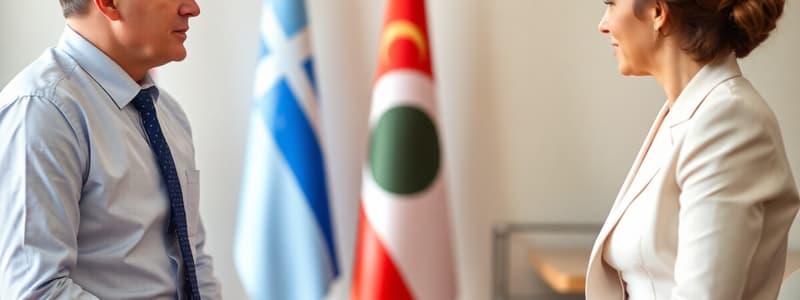Podcast
Questions and Answers
What is the main task of diplomatic services?
What is the main task of diplomatic services?
- To conduct military operations
- To establish trade relations
- To influence domestic policy
- To ensure peaceful relations (correct)
What are the focus areas of diplomacy?
What are the focus areas of diplomacy?
Political, economic, cultural, scientific
Diplomacy is only practiced by heads of state.
Diplomacy is only practiced by heads of state.
False (B)
Which of the following views defines traditional diplomacy?
Which of the following views defines traditional diplomacy?
What is diplomacy primarily aimed at?
What is diplomacy primarily aimed at?
What are the primary weapons used by diplomats?
What are the primary weapons used by diplomats?
When did records of treaties between Mesopotamian city-states date from?
When did records of treaties between Mesopotamian city-states date from?
Akkadian became the first diplomatic language, serving as the international tongue of the ________.
Akkadian became the first diplomatic language, serving as the international tongue of the ________.
Flashcards are hidden until you start studying
Study Notes
Diplomacy
- Diplomacy is the practice of states conducting relations to ensure peace.
- Diplomatic services aim to protect national interests abroad.
- Diplomacy is the art of negotiations between representatives of states.
- Diplomacy is the established method of influencing the decisions and behavior of foreign governments and peoples.
- Diplomacy focuses on political, economic, cultural, and scientific areas.
Traditional and Non-Traditional View
- The traditional view states that diplomacy maintains peace and avoids war, ignoring non-state actors in transnational diplomacy.
- The non-traditional view defines diplomacy as relations between groups to avoid conflict, acknowledging the rise of non-state actors like NGOs and MNCs.
Nature and Purpose
- Diplomacy is the primary instrument of foreign policy, but not the only one.
- Foreign policy establishes goals and strategies for diplomacy to achieve.
- Foreign policy can include other methods like using secret agents, war, or violence to achieve its objectives.
- Diplomacy is the main alternative to the use of force.
- The purpose of diplomacy is to strengthen the state or organization it serves in relation to others.
- Diplomacy aims to maximize advantages without using force or causing resentment.
- Diplomacy strives to maintain peace and resolve issues through negotiations.
Diplomacy in Times of Peace
- Diplomacy can involve coercive threats of economic or punitive measures.
- Diplomacy can demonstrate the capability to impose unilateral solutions using military power.
- Diplomacy seeks to develop goodwill towards the state it represents.
- Diplomacy focuses on building international order for nonviolent conflict resolution and cooperation.
Diplomats
- Diplomats are the primary practitioners of diplomacy.
- Diplomats are specialists in conveying messages and resolving disputes between states and peoples.
- Diplomats help leaders understand foreign attitudes and actions.
- Diplomats develop strategies to influence the behavior of foreigners, especially governments.
History of Diplomacy
- Early societies had attributes of states, and international law emerged from intertribal relations.
- Tribes negotiated marriages and regulations on trade and hunting.
- Messengers and envoys were accredited, sacred, and inviolable; they were received with elaborate ceremonies.
- Women were often used as envoys due to their perceived sanctity and use of “sexual wiles”; believed to negotiate peace in primitive cultures.
- Most knowledge of early diplomacy comes from the Middle East, Mediterranean, China, and India.
- Treaties between Mesopotamian city-states date back to 2850 BCE.
- Akkadian (Babylonian) served as the diplomatic language for the Middle East until replaced by Aramaic.
- Diplomatic correspondence from the 14th century BCE existed between the Egyptian court and a Hittite king.
Studying That Suits You
Use AI to generate personalized quizzes and flashcards to suit your learning preferences.



